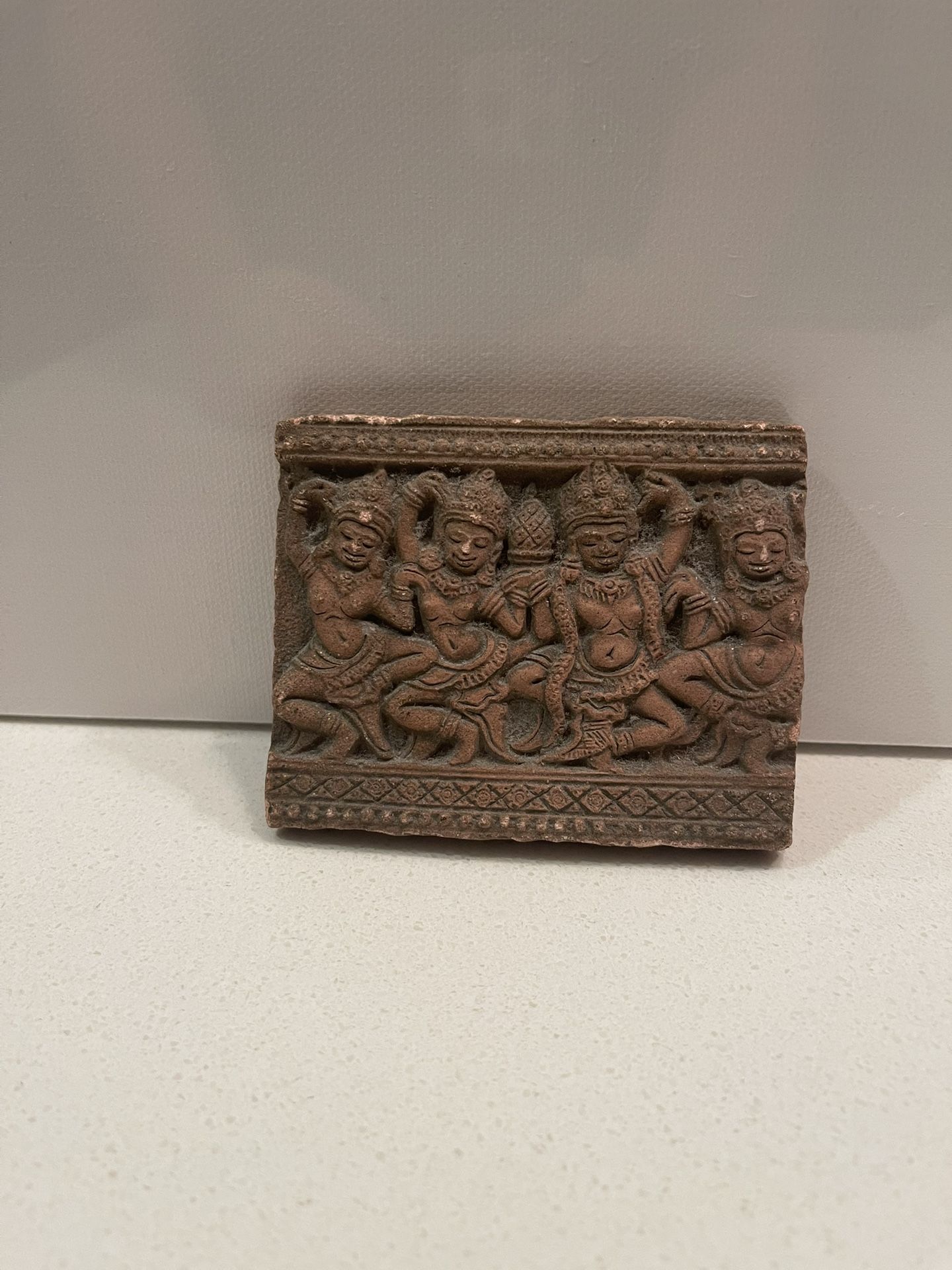Take action
$386
Dancing Asparas Stone Temple Relief Angkor Wat
Ships for $9.99
Last updated about 2 months ago in San Diego, CA
Listed in categories:
Sold by
Get a second opinion
Chat securely on the app
2-Day Purchase Protection
Items shipped through OfferUp come with a 2-day purchase protection.

Additional images
Description
The Dancing Apsaras (Celestial Dancers) of Angkor Wat (Temple City). Presumed a souvenir work of the 20th Century symbolic of the temple reliefs found in Cambodia, Khmer, Angkor Wat Period (ca. 12th. century AD). This is a lovely symbolic relief sculpture piece from Angkor Wat of Dancing Apsaras. Featuring four unique dancers, presented on a 3 x 4in. natural sandstone carving, much like a soft brick consistency. The carving includes designs along the top and bottom. The history and significance of the dancers is shared herein. Relief is a sculptural method in which the sculpted pieces remain attached to a solid background of the same material. The term relief is from the Latin verb relevare, to raise (‘to lift back'). To create a sculpture in relief is to give the impression that the sculpted material has been raised above the background plane. When a relief is carved into a flat surface of stone (relief sculpture or relief carving), the field is actually lowered, leaving the unsculpted areas seeming higher. The degree of relief in this piece is closest to a mid-relief (mezzo rilievo). These Aspara relief carved images are symbolic of carvings in the temples of Angkor, with scenes including the Samudra manthan or "Churning the Ocean of Milk" at the 12th-century Angkor Wat. Angkor Wat (/ˌæŋkɔːr ˈwɒt/; Khmer: អង្គរវត្ត, "City/Capital of Temples") is a Hindu-Buddhist temple complex in Cambodia. was originally constructed in 1150 CE as a Hindu temple dedicated to the deity Vishnu. It was later gradually transformed into a Buddhist temple towards the end of the century. One of the largest religious structures in the world, it is regarded as one of the best examples of Khmer architecture and a symbol of Cambodia. Angkor Wat was built at the behest of the Khmer king Suryavarman II in the early 12th century in Yaśodharapura (present-day Angkor), the capital of the Khmer Empire, as his state temple and eventual mausoleum. The temple is admired for the grandeur and harmony of the architecture, its extensive bas-reliefs and devatas adorning its walls. According to the 13th-century Chinese traveller Zhou Daguan, some believed that the temple was constructed in a single night by a divine architect. The Samudra Manthana (Sanskrit: समुद्र मन्थन, ‘churning of the ocean') is a major episode in Hinduism that is elaborated in the Vishnu Purana, a major text of Hinduism. The Samudra Manthana explains the origin of the elixir of eternal life, amrita. According to the above Hindu legend, there were three categories of goddesses who emerged from the ocean, including: Lakshmi: the goddess of prosperity and wealth, who chose Vishnu as her eternal consort; Apsaras: divine damsels like Rambha, Menaka, Punjisthala, and others, who chose the Gandharvas as their companions; And, Varuni: the goddess of wine (sura) and the virgin daughter of Varuna, accepted by the devas. Apsaras (Sanskrit: अप्सरस्, IAST: Apsaras, Pali: अच्छरा, romanized: Accharā Khmer: អប្សរា) are a class of celestial beings in Hindu and Buddhist culture. They were originally a type of female spirit of the clouds and waters, but, later play the role of a "nymph" or "fairy". They figure prominently in the sculptures, dance, literature and paintings of many South Asian and Southeast Asian cultures. The apsaras are described to be beautiful, youthful and elegant, and are said to be able to change their shape at will; making anyone fall for their beauty. There are two types of apsaras—laukika (worldly) and daivika (divine). They are great in the art of dancing, and often wives of the gandharvas, the court musicians of Indra. The apsaras reside in the palaces of the gods and entertain them by dancing to the music made by the Gandharvas. The twenty-six apsaras of Indra's court are each said to symbolise a different facet of the performing arts, drawing comparisons to the Muses of ancient Greece. They are also renowned for seducing rishis in order to prevent them from attaining divine powers. Urvashi, Menaka, Rambha, Tilottama and Ghritachi are the most famous among the apsaras. Angkor Wat is decorated with depictions of apsaras and devatas with more than 1,796 documented depictions of devatas in the research inventory. The architects also used small apsara images as decorative motifs on pillars and walls. They incorporated larger devata images more prominently at every level of the temple from the entry pavilion to the tops of the high towers. Sappho Marchal published a study cataloging the remarkable diversity of their hair, headdresses, garments, stance, jewellery, and decorative flowers depicted in the reliefs, which Marchal concluded were based on actual practices of the Angkor period. Apsaras on Hindu Temple at Banares: The origin of 'apsara' is the Sanskrit अप्सरस्, apsaras (in the stem form, which is the dictionary form). Note that the stem-form ends in 's' as distinct from, e.g. the nominative singular Rāmas / Rāmaḥ (the deity Ram in Hindi), whose st
Details
Condition
Used (normal wear)
Type
Relief
Item location map
Map is approximate to keep seller’s location private.
Related searches
- Antique dresser
- Antique furniture
- Antique desk
- Antique table
- Antique mirror
- Antique clocks
- Antique chairs
- Antique cabinets
- Antique bottles
- Antique armoire
- Antique lamps
- Antique dolls
- Antique china
- Antique glass
- Vintage lamp
- Vintage pyrex
- Candelabra